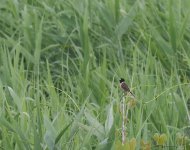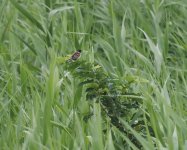I spent the morning of July 4th exploring the Shiretoko Peninsula. My first stop was along
Iwaobetsu Hot Spring Road, which had some attractive forest along a river valley. A couple of juvenile
Brown Dippers were along the river and the area was good for
Meadow Buntings. My first
Black Woodpecker of the trip (indeed my first ever in Japan) flew across the road. Soon after, a guy stopped in his car and told me there was a bear about 500 metres further along the road. Suggesting I might be wise to go back to my car, I did so and drove up the road to see if I could find the bear. Sadly, it seemed to have moved on.
I then went up the road to the
Five Lakes car park (one of the only places in Japan I had to pay to park). A couple of
Japanese Grosbeaks perched briefly in a tree but then the low cloud came down and things were pretty misty along the boardwalk. I did manage to see an
Olive-backed Pipit and a few
Latham's Snipes were gurgling.
I went back to my hotel to check out and then headed up along the road over Shiretoko Pass. Sadly, the pass was also really misty and there wasn't much to see there. I headed down the other side and spent a bit of time in the vicinity of
Rausu Hot Spring campground. The small dam near here proved very productive. I immediately saw a very nice pair of
Crested Kingfishers, closely followed by a much smaller
Common Kingfisher and a female
Mandarin Duck. I then noticed a pair of
Long-billed Plovers circling about calling in protective fashion. One of the landed nearby to give excellent views. At the campground itself, I had good views of a
Grey-headed Woodpecker that came down onto the ground to feed. At the nearby visitor centre, I stumbled rather fortuitously on an erupting geyser, something I wasn't expecting.
In the afternoon, I continued south along the coast. A stop at the roadside
Shunbetsu Estuary was quite pleasant. An
Oystercatcher (of the isolated and potentially splittable east Asian subspecies) was loafing about, along with good numbers of
Scaup and
Goosander. Passerines included
Middendorf's Grasshopper Warbler, Black-browed Reed Warbler and
Siberian Rubythroat.
I arrived at Lodge Furen, where I would be spending the next couple of nights. Sadly, the propriety Takeyoshi was away so I was looked after by his wife and daughter. The weather was quite cool and breezy by this stage. I had a look around the
lakeside boardwalk over the bridge near the lodge for a while. Things were quiet but I did find a couple of pairs of
Red-crowned Cranes, as well as the usual
White-tailed Eagles. Five
Chestnut-cheeked Starlings were around the lodge on my return.
































